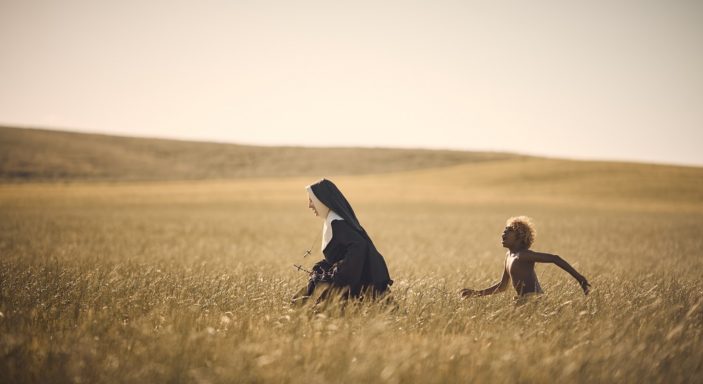
The themes tackled throughout Warwick Thornton‘s The New Boy are presented with symbolic, almost-magical and allegorical physicality. And though its 1940’s Australian setting lends interesting conversation to its religious outlay and the clashing of beliefs at the time, the film itself doesn’t quite contain the spark needed to earn true impact; though it’s not for a lack of trying.
There’s a relentless intensity to now the film opens. A power play between a young Aboriginal boy and an older white man, his small but powerful legs wrap around the man’s neck in a manner that suggests the young one has the upper hand. As the sand whips around them in their struggle, the boy is ultimately subdued in a shot that smacks with all the brutality as intended.
This young boy is the titular moniker (beautifully realised by newcomer Aswan Reid), and following the opening scuffle he’s delivered in the middle of the night to a secluded orphanage. Here we are introduced to Sister Eileen (Cate Blanchett, delivering a tender and, at-times, particularly humorous performance), who scolds the men for delivering him in the manner they have and instantly notes the boy’s terror and confusion.
It doesn’t take long for the boy to warm to Sister Eileen, and beyond that his own footing with the fellow boys at the orphanage – there are some typical sequences exploring in-room politics with the boys themselves – all the while a certain intense fascination with a recently-delivered crucifix leads to the inclination of the boy’s religious beliefs and his “spark” fading over time, suggesting a loss of his own heritage and a forcing into the practice of Christianity.
There’s an interesting conversation to be had around The New Boy and what it presents pertaining to religion and belief autonomy, and Thornton is lushly nuanced in this delivery, leaning into a far more metaphorical temperament in the film’s first half. The analogy may be a little oversaturated by the time The New Boy finishes, but Thornton is so evidently committed to and passionate about this story that any ill-fitting execution can’t dismiss the film as a whole.
Visually, the film is stunning as it showcases the quaint, vast landscape of the Australian outback. The manner in which Thornton has captured the land enhances the atmospheric temperament of the story he’s telling, which is further magnified by its performances. Reid expresses a curiosity that is inherently endearing. He’s gentle, despite his combative nature at times, and his wide eyed innocence plays well off Blanchett, who he essentially shadows for the film’s duration. Blanchett, despite initially appearing with a demeanour that could suggest her Sister is a tyrannical force, expresses a stern tenderness throughout, leaning into her underrated talents as a comedienne and speaking to her effortless nature as a motherly, caring presence as she favours the young boy, though not to the detriment of her flock. They’re both well balanced by Deborah Mailman as “Sister Mum”, the supremely lovely co-host (of sorts) to Sister Eileen; Mailman truly delivering the film’s biggest laughs as she yings to Reid’s yang as he tests the boundaries of her authority.
It can’t be denied how fascinating The New Boy‘s story is. The symbolic nature of the film detailing a young Aboriginal boy’s colonisation and the stripping of his heritage is something that needs to be experienced, and Thornton’s approach in making the film to appear as less heavy-handed as possible is a clever tact in reminding the masses of Australian history and how integral that reminder deserves to be.
![]()
![]()
![]()
![]()
![]()
THREE AND A HALF STARS (OUT OF FIVE)
The New Boy is screening as part of this year’s Sydney Film Festival, running between June 7th and 18th, 2023. For more information head to the official SFF page.
The New Boy is scheduled for a national release in Australian theatres from July 6th, 2023.
